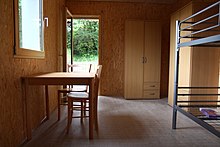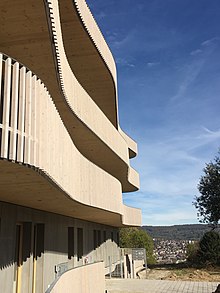Hope Bearer Foundation
| Hope Bearer Foundation | |
|---|---|

|
|
| legal form | Foundation under civil law |
| founding | May 22, 2013 |
| founder | Tobias Merckle (Chairman of the Board of Trustees) |
| Seat | Leonberg , Germany |
| motto | So that people become bearers of hope |
| main emphasis | Help for children of prisoners, refugees and young people in socially disadvantaged areas |
| method | Sponsorships, integrative housing projects, financial support for social projects |
| Action space | Germany, Zambia, Colombia, Cambodia, etc. a. |
| Chair | Marcus Witzke (board member) |
| Website | www.hoffnungstraeger.de |
The Hope Bearers Foundation is a foundation under civil law based in Leonberg ( Baden-Württemberg ). It was founded in 2013 by Tobias Merckle, son of the entrepreneur and Ratiopharm founder Adolf Merckle and his wife Ruth Merckle from Blaubeuren near Ulm . Tobias Merckle is Chairman of the Board of Trustees. Other founding board members were Jürgen Kugler ( Landesbank Baden-Württemberg ), Achim Halfmann (managing editor CSR News), Ruth Merckle † (entrepreneur), Thorsten Riewesell (chairman of Jumpers), Michaela Stitz (consultant) and Christoph Waffenschmidt (chairman of the board of World Vision Germany ).
aims
The Hope Bearer Foundation wants to support people who are looking for protection and a dignified life. She is committed to the integration of refugees and migrants in Germany and arranges sponsorship for children around the world whose fathers or mothers are in prison. The foundation also supports selected social projects at home and abroad. The work is financed from the foundation's income and donations.
Areas of work in Germany
Hope carrier has developed its own concept for the integration of refugees. In addition to the integrative living of locals with refugees, the concept also provides for social work , language education , training and employment . The activities are embedded in a broad local network of volunteer work. The building blocks mentioned are intended to help people who have come to Germany quickly feel at home and lead an independent life.
Hope houses
The concept of hope for the integration of refugees should be able to be multiplied nationwide. Together with the Urban Development Institute of the University of Stuttgart and the architecture firm andOffice, the foundation has developed a model that can be implemented in every municipality: the house of hope. It is characterized by a modular construction, flexibility, the use of wood as a central building material and sustainability. Refugees are deliberately housed in houses of hope together with locals who help them get started with the new culture. The hope houses are set up together with local initiatives that are already taking care of immigrants, so that a network of voluntary helpers is available. There are locations a. in Schwäbisch Gmünd, Esslingen, Bad Liebenzell and Leonberg. The first house of hope opened in 2016 with the purchase and renovation of a property in Leonberg, Baden-Württemberg.
The Hope Bearers Foundation runs the houses independently or together with cooperation partners, depending on the location. The volunteer residents make the house of hope individual and unique. Other volunteers support the offers. Each house of hope has a site manager who plays a decisive role in shaping the house. The concept consists of the following building blocks:
Living together
- Active house community that shares their everyday life with each other - usually consists of local and refugee residents in equal parts
- Opportunity for joint activities and mutual support
Social work and language education
- Individual help, support with official matters or visits to the doctor
- Procedural support
- Mediation of external language courses
- On-site language courses
Society and volunteering
- Open educational and meeting formats
- Voluntary commitment and cooperation
- Accompaniment and encounter in everyday life
- Participation in working groups
- Cooperation in the network
Training and work
- Support in looking for work and training positions
- Employer network
- Support in training and employment
Spiritual life
- Interfaith meeting formats
- Cooperation with local communities and working groups
- Meeting at eye level
architecture
The architecture of the Hope Houses, designed by the architecture firm andOffice, with its self-contained apartments and common rooms, represents an interplay of community and opportunities for retreat for residents. In addition, balconies running in opposite directions enable communication across the floors. The central building material wood is supposed to provide a warm and lively atmosphere and at the same time enables affordable living space. The rounded corners of the building are reminiscent of two hands wrapped protectively around the house and residents.
The foundation has received various awards for the architecture of the Hope Houses. These include:
- German Design Award Special, 2019
- HolzbauPlus. Federal competition - building with renewable raw materials, 2018 (honorable mention)
- Timber Construction Award Baden-Württemberg, 2018 (recognition)
- Exemplary building Chamber of Architects Baden-Württemberg, 2018 (award)
- Heinze ArchitektenAward Best Residential Buildings Shortlist, 2018
- Iconic Awards - Innovative Material, 2018 (Winter)
Integration award
For its integrative work for refugees, the Hope Bearers Foundation was awarded the Integration Prize of the State of Baden-Württemberg on May 21, 2019 . With their concept “House of Hope” they achieved third place in the civil society category.
Sponsorship program for children of prisoners
Another field of activity of the hopefuls are sponsorships for the children of prisoners. There are millions of children worldwide with at least one parent in prison. That makes them outsiders in society. Around a million of them live in poverty and face hunger, violence and exploitation. The risk that these children will later become criminals themselves is between three and seven times higher. The hopefuls are working with local project partners to ensure that prisoners' children receive regular meals and medical care. In addition, it is ensured that the children have a safe environment, attend school and can develop their potential. The children also receive psychological support if necessary and the opportunity to visit their father or mother in prison.
Reconciliation programs
In Colombia , the Hope Bearers Foundation works for the reconciliation of the people in the regions of civil war . The focus of the initiatives of the foundation and its partner Confraternidad Carcelaria de Colombia are the villages of reconciliation . Former guerrillas are working with local residents to create an intact infrastructure for victims of the civil war. They build or renovate houses and schools, set up workshops or make agricultural land usable. The aim is to pave the way back to life for FARC rebels and villagers.
Support of volunteers
Because the support of volunteers in refugee work is also one of the concerns of the Hope Bearers Foundation. For this group of people there are special offers for advice, networking and training as well as a funding program for projects.
Web links
Individual evidence
- ^ Statutes of the Hope Bearers Foundation. (PDF) Retrieved February 8, 2017 .
- ↑ Tobias Merckle (Vita). Retrieved February 9, 2017 .
- ↑ a b c Hopefuls support projects for refugees (article from the Stuttgarter Zeitung). Retrieved February 8, 2017 .
- ↑ Self-presentation of the Hope Bearers Foundation on the Internet. Retrieved August 20, 2017 .
- ↑ Portrait of the Hope Bearers Foundation, self-portrayal. (PDF) Retrieved February 8, 2017 .
- ↑ Hope houses (description on the andoffice website). Retrieved February 8, 2017 .
- ^ Apartments for refugees and students, article from the Black Forest messenger. Retrieved February 8, 2017 .
- ↑ Sinsheim plans "Hoffnungshaus" for refugees and locals (article from the Rhein-Neckar-Zeitung). Retrieved February 8, 2017 .
- ↑ Integration right under the roof. Description of the Hope Houses on the Foundation's website. Retrieved February 8, 2017 .
- ↑ Integrative Living: The Hope Houses. Retrieved July 16, 2019 .
- ↑ Hope houses: The thoughts behind the architecture. Retrieved July 16, 2019 .
- ↑ Stuttgarter Zeitung, Stuttgart Germany: Leonberg: Hope Bearers Foundation receives the integration award. Retrieved July 16, 2019 .
- ^ Prison Fellowship International - the Problem. Retrieved February 8, 2017 .
- ↑ Take part and become a sponsor now (website of the Hope Bearers Foundation). Retrieved February 8, 2017 .
- ^ Confraternidad Carcelaria de Colombia. Retrieved February 8, 2017 .
- ↑ Hope in Colombia. Retrieved February 8, 2017 .


